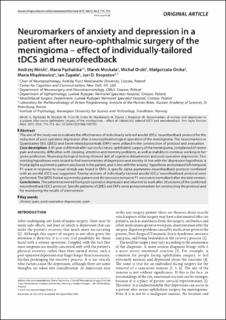| dc.contributor.author | Mirski, Andrzej | |
| dc.contributor.author | Pachalska, Maria | |
| dc.contributor.author | Moskala, Marek | |
| dc.contributor.author | Orski, Michal | |
| dc.contributor.author | Orska, Malgorzata | |
| dc.contributor.author | Miaskiewicz, Maria | |
| dc.contributor.author | Zapala, Jan | |
| dc.contributor.author | Kropotov, Yury | |
| dc.date.accessioned | 2020-03-20T10:19:39Z | |
| dc.date.available | 2020-03-20T10:19:39Z | |
| dc.date.created | 2016-02-26T16:59:49Z | |
| dc.date.issued | 2015 | |
| dc.identifier.citation | AAEM: Annals of Agricultural and Environmental Medicine. 2015, 22 (4), 718-723. | en_US |
| dc.identifier.issn | 1232-1966 | |
| dc.identifier.uri | https://hdl.handle.net/11250/2647769 | |
| dc.description.abstract | The aim of the study was to evaluate the effectiveness of individually tailored anodal tDCs/ neurofeedback protocol for the reduction of post-operative depression after a neuroophtalmological operation of the meningioma. The neuromarkers in Quantitative EEG (QEEG) and Event-related potentials (ERPs) were utilized in the construction of protocol and evaluation. Case description. A 45-year-old female after successful neuro-ophthalmic surgery of the meningioma, complained of severe pain and anxiety, difficulties with sleeping, attention and memory problems, as well as inability to continue working in her given profession. Neuropsychological testing showed lack of cognitive disturbances and post-operative depression. Two working hypotheses were tested to find neuromarkers of depression and anxiety. In line with the ‘depression hypothesis’ a frontal alpha asymmetry pattern was found in the patient, and in line with the ‘anxiety’ hypothesis an increased left temporal P1 wave in response to visual stimuli was found in ERPs. A specific alpha asymmetry neurofeedback protocol combined with an anodal tDCS was suggested. Twenty sessions of individually-tailored anodal tDCs/ neurofeedback protocol were performed. The QEEG frontal asymmetry pattern and the excessive temporal P1 wave were normalized after the intervention. Conclusions.The patient recovered from post-operative depression and returned to work after 20 sessions of the combined neurofeedback/tDCS protocol. Specific patterns of QEEG and ERPs serve as neuromarkers for constructing the protocol and for monitoring the results of intervention. | en_US |
| dc.language.iso | eng | en_US |
| dc.publisher | The Institute of Rural Health | en_US |
| dc.rights | Navngivelse-Ikkekommersiell 4.0 Internasjonal | * |
| dc.rights.uri | http://creativecommons.org/licenses/by-nc/4.0/deed.no | * |
| dc.title | Neuromarkers of anxiety and depression in a patient after neuro-ophthalmic surgery of the meningioma - Effect of individually-tailored tDCS and neurofeedback | en_US |
| dc.type | Peer reviewed | en_US |
| dc.type | Journal article | en_US |
| dc.description.version | publishedVersion | en_US |
| dc.source.pagenumber | 718-723 | en_US |
| dc.source.volume | 22 | en_US |
| dc.source.journal | AAEM: Annals of Agricultural and Environmental Medicine | en_US |
| dc.source.issue | 4 | en_US |
| dc.identifier.doi | 10.5604/12321966.1185783 | |
| dc.identifier.cristin | 1340469 | |
| dc.description.localcode | Attribution-NonCommercial 3.0 Poland (CC BY-NC 3.0 PL) | en_US |
| cristin.unitcode | 194,67,40,0 | |
| cristin.unitname | Institutt for psykologi | |
| cristin.ispublished | true | |
| cristin.fulltext | original | |
| cristin.qualitycode | 1 | |

